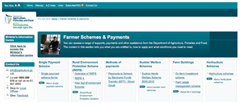Transforming service delivery through technology
 eolas highlights some of the technology being used by the Department of Agriculture, Fisheries and Food, as discussed by Michael Bunyan, Director of Information Management and Technology.
eolas highlights some of the technology being used by the Department of Agriculture, Fisheries and Food, as discussed by Michael Bunyan, Director of Information Management and Technology.
The Department of Agriculture, Fisheries and Food (soon to be agriculture, food and marine) recognises that “IT is going to be a significant driving factor in creating efficiencies in the coming years.”
That’s according to IT Director Michael Bunyan, who spoke at an eolas ‘Innovation in public services seminar’ in April.
The Croke Park Agreement highlighted the important role IT will play in cutting public sector costs by stipulating that departments must incorporate online service provision, shared services, reuse of information and centralisation of transactions in their operations.
The department’s main role is to develop policy for the €22 billion agri-food sector at national and international level. It is also responsible for food safety, animal health, welfare regulation and the operation of a complex farmer payment system transferring up to €1.3 billion per annum (single payment system). Its customer base includes taxpayers; farmers; consumers; food processors; those involved in agriculture, food, fishing, forestry, bio-energy and research; EU institutions; other state bodies and special interest groups.
The six main eGovernment services provided by the department are:
• the Single Payment System (an amalgamation of 13 payment schemes, based on land and entitlements);
• iFORIS (allows foresters to track the processing of forestry applications submitted to the department);
• the Animal Identification and Movement (AIM) system (registration of livestock animals, recording and controlling animal movements and provision of extensive information in relation to animal herds.);
• the Animal Health Computer System (allows, inter alia, private vets to check test results the department has allocated to them and download the herd profile onto a handheld device they take with them to the relevant farm to carry out health checks);
• the Agriculture Field Inspection and Testing (AFIT) system (schedules farm inspections and reporting);
• the Electronic Recording System Project is a cross departmental project involving the Department of Agriculture, Fisheries and Food, the Sea Fisheries Protection Authority, the Department of Defence and the Naval Service. It provides a means for fishing vessels at sea to keep the authorities informed of fishing trip details and of quantities of fish caught.
The department’s ‘Food Harvest 2020’ policy document has set the following targets:
• increasing the value of primary agriculture, fisheries and forestry output by €1.5 billion;
• increasing exports from €8 billion to €12 billion by 2020; and
• increasing milk production by 50 per cent and beef production by 20 per cent.
“Agriculture disappeared in the Celtic Tiger years but people are again looking at agriculture as an economic driver,” Bunyan says. “Technology will play a significant part” in achieving these targets, he believes.
eGovernment already plays a big part in tracking animals. In 2010 the department tracked 5.826 million cattle, 3.116 million sheep and 8,686 goats. Its online services have also improved and learned from crises such as the BSE and foot and mouth outbreaks. In terms of animal health and traceability the department liaises with the Department of Communications, Energy and Natural Resources; the Department of Social Protection; the Office of the Revenue Commissioners; the EU Commission; Teagasc and Bord Bia.
It operates shared services by looking after infrastructure support for DCENR. This is because there is “a lot of synergy” between their networks and systems due to DCENR previously having responsibility for forestry and fisheries. Because of food safety requirements, the department comes under a lot of scrutiny, particularly in terms of EU directives.
The department’s website (www.agriculture.gov.ie) is used extensively by citizens and Bunyan reveals that pet passports receive the biggest amount of hits each year (800,000). However, there is a problem with getting farmers to transact their business online.
Eighty per cent of Ireland’s farmers are over 55, only seven per cent are under 35 and the majority are naturally based in rural areas. That means the department faces “a significant challenge” when it comes to getting them online.
Research commissioned by the department in 2010 (undertaken by Dr Regina Connolly of DCU) found that almost 70 per cent of farmers interviewed for the study reported low confidence in their ability to accurately complete farm administration tasks online because of fear of technology, educational knowledge and cost. It also found that farmers would prefer to delegate responsibility for their farming administration to an agent rather than use online services themselves.
In order to effect change within the department’s IT sector and get more farmers online, the department targeted the agents who showed their clients how to use online services.
Because “farmers tend to eat their dinner in the middle of the day and they tend to only watch the weather”, the department steered away from national media but placed ads on local radio “between the GAA results and the death notices” and in trade papers such as ‘The Farmer’s Journal’. These ads urged farmers to use the internet, not just for filling out farm- payment forms and submitting herd details, but for everyday items like online banking and booking holidays. This aimed to eradicate the “fear” many have of the internet.
The department has won a number of awards for its IT strategies including:
• the 2009-2010 central government category at Ireland’s eGovernment awards;
• the good practice label at the 2009 EU eGovernment awards; and
• the Taoiseach’s Public Service Excellence Award in 2010.






